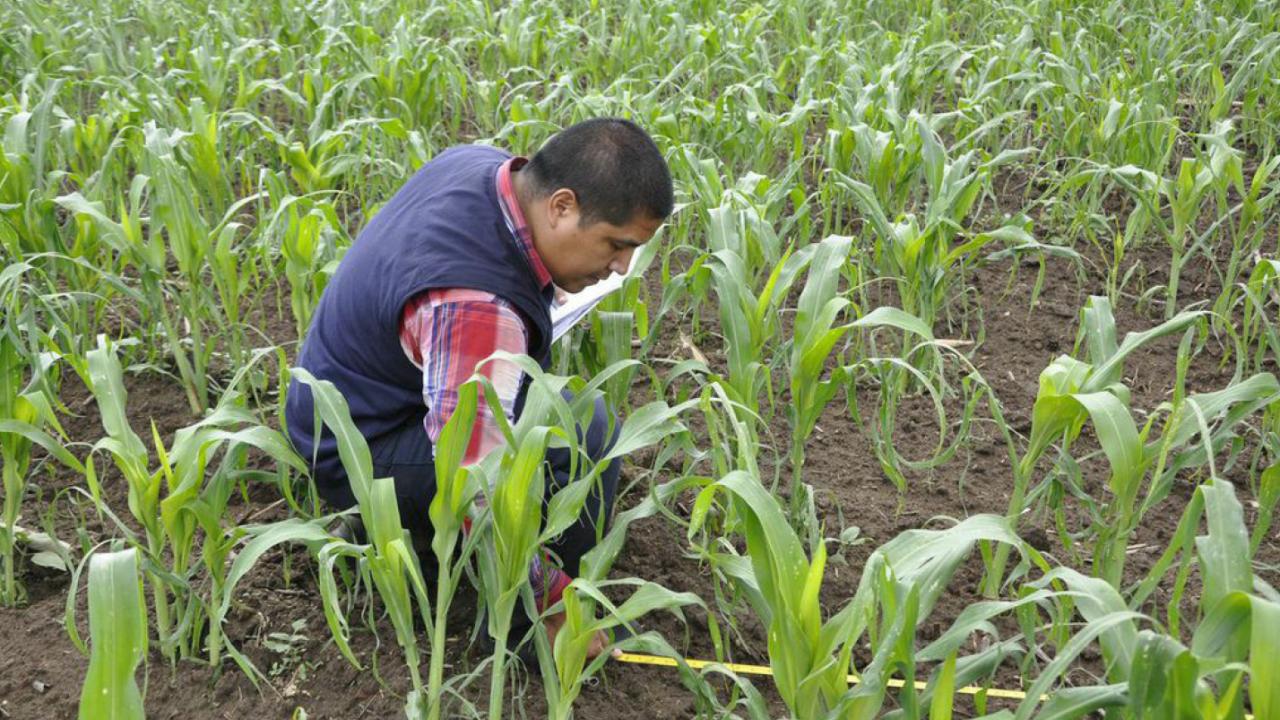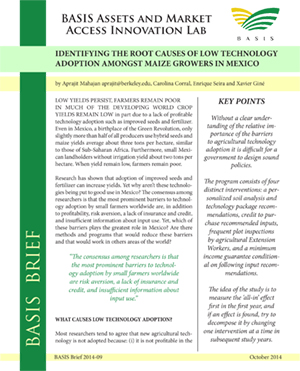
Low yields persist, farmers remain poor in much of the developing world crop yields remain low in part due to a lack of profitable technology adoption such as improved seeds and fertilizer. Even in Mexico, a birthplace of the Green Revolution, only slightly more than half of all producers use hybrid seeds and maize yields average about three tons per hectare, similar to those of Sub-Saharan Africa. Furthermore, small Mexican landholders without irrigation yield about two tons per hectare. When yield remain low, farmers remain poor.
Key Points
- Without a clear understanding of the relative importance of the barriers to agricultural technology adoption it is difficult for a government to design sound policies.
- The program consists of four distinct interventions: a personalized soil analysis and technology package recommendations, credit to purchase recommended inputs, frequent plot inspections by agricultural Extension Workers, and a minimum income guarantee conditional on following input recommendations.
- The idea of the study is to measure the ‘all-in’ effect first in the first year, and if an effect is found, try to decompose it by changing one intervention at a time in subsequent study years.
 Research has shown that adoption of improved seeds and fertilizer can increase yields. Yet why aren’t these technologies being put to good use in Mexico? The consensus among researchers is that the most prominent barriers to technology adoption by small farmers worldwide are, in addition to profitability, risk aversion, a lack of insurance and credit, and insufficient information about input use. Yet, which of these barriers plays the greatest role in Mexico? Are there methods and programs that would reduce these barriers and that would work in others areas of the world?
Research has shown that adoption of improved seeds and fertilizer can increase yields. Yet why aren’t these technologies being put to good use in Mexico? The consensus among researchers is that the most prominent barriers to technology adoption by small farmers worldwide are, in addition to profitability, risk aversion, a lack of insurance and credit, and insufficient information about input use. Yet, which of these barriers plays the greatest role in Mexico? Are there methods and programs that would reduce these barriers and that would work in others areas of the world?
What Causes Low Technology Adoption?
Most researchers tend to agree that new agricultural technology is not adopted because: (i) it is not profitable in the current context, (ii) farmers do not have the money to purchase it even if profitable and, (iii) farmers are unaware about its profitability or, given the risk it entails, they are unwilling to experiment with it. A consensus view is that poorly developed loan and insurance markets in low-income countries interact with high levels of risk aversion and a lack of information thus leading to low technology adoption by poor households. However, the literature is divided on the absolute and relative importance of these different constraints.
Without a clear understanding of the relative importance of the barriers to agricultural technology adoption it is difficult for a government to design sound policies. For example, if high transport costs prevent additional production from being sold, then investments in infrastructure may be warranted. Credit market failures may hinder farmers’ ability to get a loan, while failures in insurance markets may turn experimentation and learning into a costly affair. This lack of understanding likely explains why government programs have met with mixed success.
The Technological Guarantee Program (TGP) Evaluation
The Technological Guarantee Program (TGP) is administered by the Trust Funds for Rural Development (FIRA), a development bank that has a mission to offer credit backed by training, technical assistance and technology transfer support for agriculture, livestock fishing, forestry, and agribusinesses. FIRA is a significant actor in the Mexican agricultural sector serving approximately 1.6m farmers and working in all 32 Mexican states.
The purpose of the TGP is to increase yields by simultaneously addressing three important barriers to technology adoption: lack of and uncertain credibility of information, limited access to credit, and risk-aversion The TGP is being implemented in Tlaxcala state and targets maize farmers with less than 10 hectares of land with yields between 0.6 and 2.5 tons per hectare in the previous agricultural cycle. The program consists of four distinct interventions that directly address these three barriers.
A personalized soil analysis and technology package recommendation. The package includes production inputs, seeds, fertilizer, pesticide, herbicide, and conservation agriculture procedures based on the soil analysis. This intervention addresses the concern that, even when using fertilizers and hybrid seeds, yields remain low because farmers lack information about the ideal input mix.
Credit to purchase recommended inputs. Farmers are offered credit to purchase the recommended input package. Unlike a typical farming loan, this loan is conditional on adopting better farming practices and receiving expert advice, thus making adoption and subsequent repayment more likely.
Frequent plot inspections by Agricultural Extension Workers (AEWs). The extension worker will visit the farms every six weeks to verify input use and to give advice on conservation agriculture methods. This addresses the concern that yields are low due to improper input use and increases the credibility of advice.
A minimum income guarantee conditional on following input recommendations. If the advice of AEWs is followed, FIRA guarantees a minimum income of 2,000 pesos per hectare. This has the dual role of reducing risk borne by farmers and also building trust in the program.
To evaluate the TGP we are implementing a randomized control trial (RCT) with a treatment arm that receives all four experimental interventions and a control arm that receives none. The idea of the study is to measure the “all-in” effect first in the first year, and if an effect is found, try to decompose it by changing one intervention at a time in subsequent study years. The study began in 2013 and is scheduled to conclude in 2016.
During the second growing season we will conduct a follow-up experiment by varying each intervention at a time. To disentangle the relevant constraints to technology adoption in Mexico we are, in effect, running a “horse-race” between the four different interventions, each targeting a single adoption constraint. This will allow us to identify the most cost-effective inputs and those that have the greatest impact on yields. In the future, we also intend to incentivize AEWs through performance-based salaries that are conditional on the yields achieved compared to the yields of a local control group.
Currently, we are planning a meeting in Tanzania and Uganda with government officials and the World Bank to disseminate the results and discuss the possibility of replicating the study with suitable partners. A second study in another country will allow us to determine if our intervention strategies are transferable and can be applied to other contexts.
Anticipated Impacts
The TGP will impact the lives of beneficiaries through two main channels. First is the direct effect on income from increased yields. Net profits should increase which in turn will have long-term effects on household welfare as incomes rise. The second benefit channel is access to credit. Most smallholder farmers have never had a loan and therefore have no credit history, which lowers the probability that they can get a loan. The TGP will break this vicious cycle by giving these farmers their first loan.
The Mexican government, through FIRA, requested this project and the associated impact evaluation. The government did this with the aim of determining how to best design the TGP before scaling it up to the entire small farmer population. FIRA will use the results to decide whether its credit programs and technology assistance programs are effective and whether its income guarantee scheme is effective at increasing adoption and yields without succumbing to moral hazard problems.
In addition, after being invited by the government and recognizing the project´s agricultural policy significance, CIMMYT is now an integral part of the project. CIMMYT intends to use the results from this study to inform their policy recommendations world-wide. In particular, they will use the results, if successful, to promote similar programs elsewhere in Africa and Asia.
This report is made possible by the generous support of the American people through the United States Agency for International Development (USAID). The contents are the responsibility of the Feed the Future Innovation Lab for Assets and Market Access at UC Davis and do not necessarily reflect the views of USAID or the United States Government.
